Dell Latitude E6410: Minding Intel's Business
by Jarred Walton on December 2, 2010 2:45 AM ESTLCD: Matte but Mediocre
Back to a look specifically at the E6410, here's how the LCD panel rates. We like the resolution, we like the maximum brightness, but the contrast rates near the bottom of our charts and as a result the colors look washed out. Matte doesn't have to be low contrast (i.e. the MacBook Pro 15 has a good matte panel), but apparently high quality LCDs are only needed in mobile workstations, MacBook Pros, and a few select other laptops (including the XPS 15's 1080p panel).
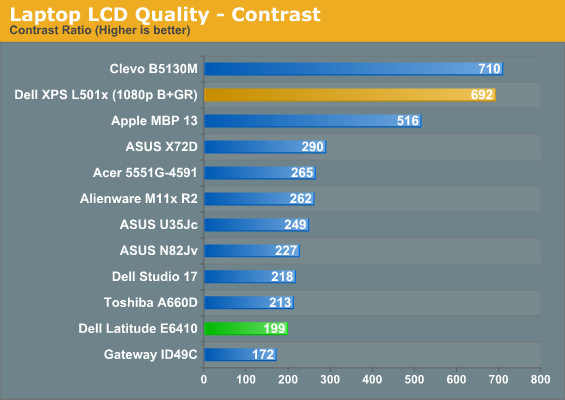

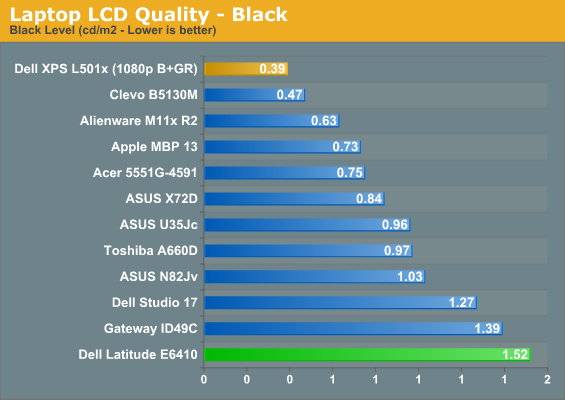
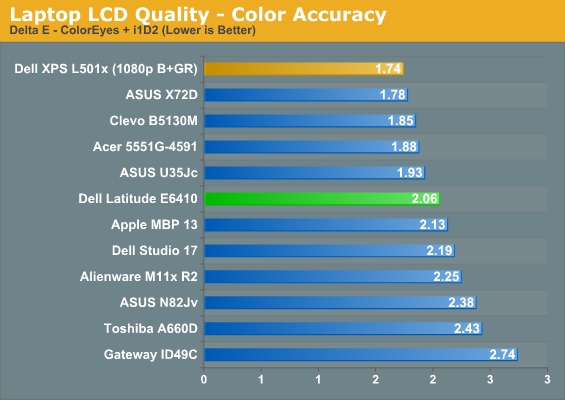
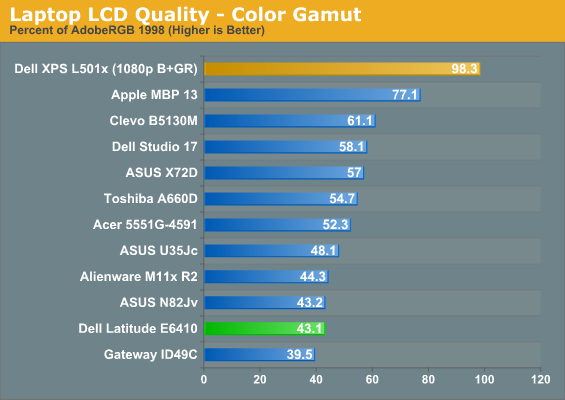
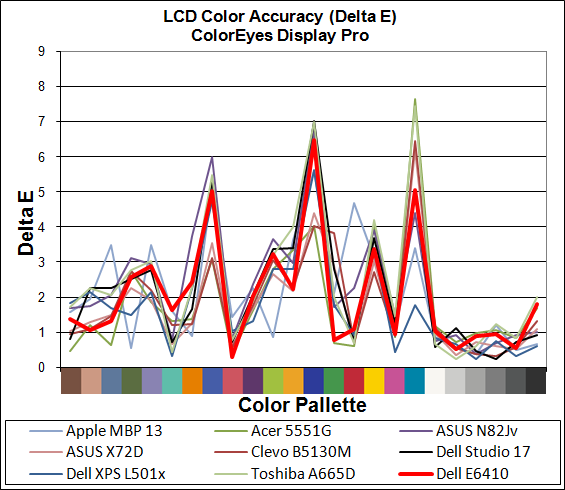
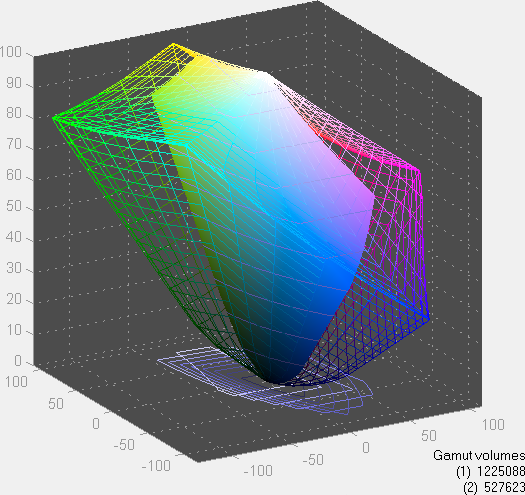
Temperatures and Noise
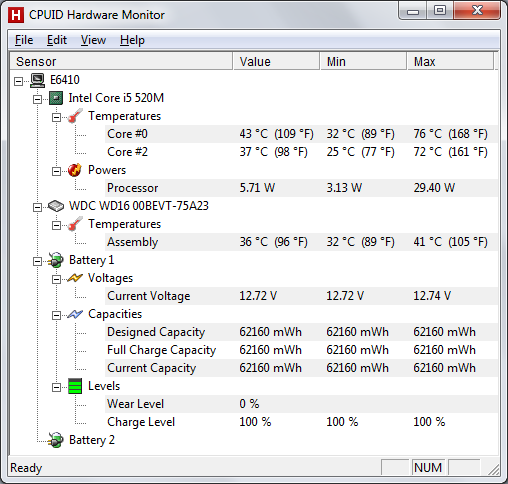
There's not a whole lot to say in regards to temperatures and noise. With only integrated graphics, the E6410 doesn't get particularly hot or loud. The CPU temperatures under load reached a maximum of 76C, and noise levels ranged from 30dB at 12" (the limit of my SPL meter) at idle and light loads to as much as 34dB with a maximum load on the CPU and GPU. In other words, if you were to use the E6410 in a meeting, your typing would be far more obnoxious than the noise from the fan.
















51 Comments
View All Comments
brshoemak - Thursday, December 2, 2010 - link
I have found that the one weakness of my Dell E6400 is the Dell Control Point software. My brand new machine felt REALLY sluggish relative to the hardware inside. After experiencing a couple BSOD's (which I never expected on a brand new machine) I deleted the Control Point suite. After that, all my BSOD issues were gone and the everything was much quicker.If you can, blow away Dell Control Point, it should take care of most performance issues. For reference I have a Dell E6400, C2D P8600, 4GB, 160GB, Quadro NVS160M.
hennes - Thursday, December 2, 2010 - link
I want to confirm the problems with the dell control point software. Some versions of it are broken. Googling will tell you which (older) versions do work. Copying some dlls manually repairs some of the problems.That said, if you do not need WAN access that you can run fine without the DCP software, and I am very happy with the E6400, E6410 and E6500's which we use at work.
For reference, my own laptop is a Latitude E6500 (C2D P8400, 4GB, Quadro NVS 160M and the good 1920x1200 display). No DCP, no sluggish performance.
Zap - Thursday, December 2, 2010 - link
WD1600BEVT is AFAIK a 5400RPM drive. The Scorpio Black are 7200RPM while Scorpio Blue are 5400RPM.JarredWalton - Thursday, December 2, 2010 - link
Whoops! You're right; I fixed the table now. I thought all of the HDDs for the E6410 were 7200RPM, but it turns out the one option where you can get a 5400RPM is the minimum 160GB drive. That's what Intel shipped me, and that's almost certainly part of the sluggishness. Dell's Control Point software is probably the other half.mike8675309 - Thursday, December 2, 2010 - link
Isn't it a sad state of affairs where a 1440 x 900 resolution in a 14" laptop screen on s business laptop is considered great. My 12.1" Toshiba M400 from years ago has 1400 x 1050 for petes sake. 2 years ago I could get a Dell Lattitude with 1920 x 1200 resolution in a 15" panel. WTH has happened to the world where the highest resolution you can get in a 20" panel is only 1920 x 1080?I don't care if a movie looks good on my computer, I just want to be able to get some work done, sigh.
JarredWalton - Thursday, December 2, 2010 - link
I'd say going higher resolution on 14" will displease the vast majority of users. Enthusiasts and people with great eyesight might be happy, but I've had more than a few encounters with people over the years that think current resolutions make everything "too small". I know our readership is mostly in the 20-35 year old range, but the majority of business people are in the 35+ bracket. Personally, I also find anything more than 900p/WXGA+ at 14" to be too small. Similarly, 768p on a 10" netbook gives you very small pixels. I'd say the vast majority of regular users would prefer the following resolutions:10" and smaller: sadly, 1024x600 is probably enough.
11.6-13.3": 1366x768 or 1280x800.
13.3-14.1": 900p or 1440x900
15-16": Here you can finally go 900p to 1080p
17" and larger: 900p minimum to 1080p or WUXGA.
There's some overlap, especially on the larger side of the scale, but if you gave me 1080p in a 13" LCD I'd be squinting all day long. And before you ask, no, glasses won't help my situation (although corneal replacement might... yeah, a bit extreme if I don't *need* to have it done).
mike8675309 - Thursday, December 2, 2010 - link
I guess I never have believed that people actually prefer the resolution on these displays. I write, QA, Debug code all day long. Dealing with low resolution displays is o.k. much of the time, but sometimes it becomes unbelievably frustrating. Scroll code up, scroll code down, up, down, up, down.Is there a laptop today, that even is available with a WUXGA screen? The smallest LCD monitor in WUXGA is 24" which is crazy big. Do we really want to have to physically move our head to do our work?
Consider the monitors of 2 to 3 years ago. A typical business class LCD monitor in a 17" size was 1280 x 1024. Tech from 3 years ago. And today, 1440 x 900, something with significantly less horizontal real-estate is considered Great. Great for what? Browsing websites, which most of their content is either up or down? Working on spreadsheets, which has content in both planes? Working on Visio Diagrams, Writing E-mails, writing C# code? About the only thing having wider yet shorter resolution is good for is people who don't like to see black bars when they watch movies.
I appreciate the reviews here, I agree the displays in laptops need to be much better, I just think they also need to do something to improve the resolution, especially in business class machines. People are supposed to be working, not watching movies (at least for most businesses). Why are these machines following along with consumer grade equipment being optimized for movie watching?
JarredWalton - Thursday, December 2, 2010 - link
The aspect ratio wars are unfortunately pretty much done and over, and the winner is 16:9... but thankfully most business laptops still stick with 16:10. I agree that 16:9 is a lousy choice, and I was happier with 16:10. I'm not sure when the last time was that anyone manufactured a 4:3 or 5:4 laptop; my wife has a 4-year-old Latitude that's 1280x800, so I think it's probably more like 5-6 years since 1280x1024 was readily available.One thing to keep in mind is that wider also worked out better for keyboards. You can make a reasonable sized keyboard fit in a 13.3" widescreen chassis, whereas a 13" 4:3 or 5:4 would be more like the width of a 12.1" widescreen chassis. Remember the old ThinkPad with the butterfly keyboard? So it's a balancing act between how many LCD panels they can get out of a certain size glass substrate, how big they can make the keyboard, how light they can make a laptop, etc.
I'd say movies and games benefit from being wider, and on a higher resolution display you can do two pages side by side in Word. For spreadsheets it's a wash, and for coding if you can do side-by-side view it may help as well (decrease the indent to 2-3 spaces instead of 8 maybe?) It really depends on how you use your system, but there are certainly times when the opposite of widescreen is desirable (i.e. portrait view for reading long web pages).
As for WUXGA laptops, you can still find them, but choices are limited. 17" business laptops (Dell Precision, HP EliteBook) and the MacBook Pro 17 have WUXGA panels I believe.
mike8675309 - Thursday, December 2, 2010 - link
Get a handle on one of those WUXGA laptops and take a look at it from the approach of productivity. Compare those to perhaps their same version with their standard display from that aspect. And then perhaps discuss the trade off in real-estate vs visual pain vs cost.I think the cost piece is where it would push it over the edge, i.e. the dell m6500 precision is a $300 premium for WUXGA. (yes, the apple 17" mackbook pro has WUXGA)
Interestingly, high rez macs are not new, as there are some posts out there of folks sticking a WUXGA resolution 15" panel into older Mac Book Pros. Apparently I'm not the only one that would prefer a little higher rez.
http://forums.macrumors.com/showthread.php?t=20775...
Penti - Friday, December 3, 2010 - link
Why don't hook up your laptop to your dock and a high-res screen at work? That's really why you have business laptops to begin with. Docking capabilities, maybe now days (comes in after docking though) support for AMT/vPro and remote administration features. At the road you have to sacrifice some, at the desk you should have 1920x1200 S-IPS for $400 or better. A good 2560x1440 screen shouldn't cost more then $1000, and you can skimp on the workstation laptop instead and possibly get by with a more usable business model. Some compromises has to be made at least if you want <17".